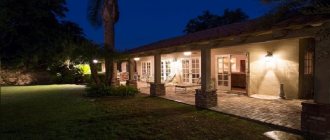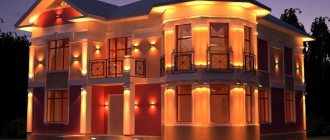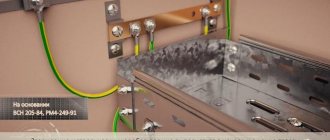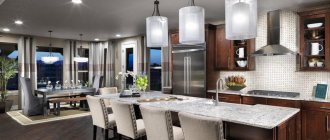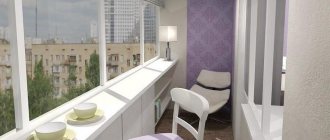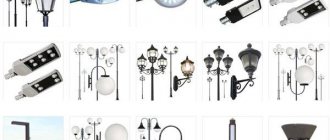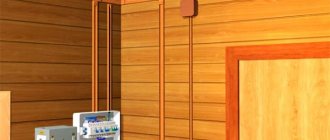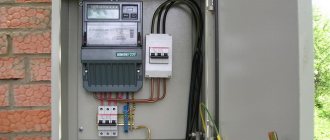In any room, building or structure, in addition to the main lighting necessary for effective operation, an auxiliary type is installed, the functioning of which is regulated using technical, legislative and sanitary standards. Emergency lighting is installed even in premises with a minimum number of employees working in them.
In the event of an accident, fire or other force majeure, a situation often arises where the main system fails. This leads to panic, chaos, disorganized evacuation, injuries and even death. An emergency lighting system allows employees to leave the building in an orderly manner, minimizing physical damage and possible losses.
Regulatory documents and rules
The main document that all designers are guided by is SP (set of rules) 52.13330 of 2016. According to its content, emergency lighting includes evacuation and backup types.
The main task of the 1st category is to provide conditions for the emergency evacuation of people through corridors, exits, and staircases.
This in turn is divided into lighting:
- evacuation routes of ordinary buildings: entertainment and shopping centers, schools, hypermarkets, offices, cinemas;
- special danger zones in industrial workshops and large enterprises;
- anti-panic type, whose main task is to suppress panic and crush in crowded places.
Interesting! Backup lighting is installed in rooms where stopping the production process is dangerous to the life and health of people (surgical operating rooms, air traffic control rooms).
The design of any type of lighting is clearly regulated by federal laws, fire safety regulations, quality standards and sanitary norms. Designers are guided by the following list of documents:
- Federal Law No. 123;
- SP 31-110 from 2003;
- SP 3.13130 from 2009;
- SP 52.13330 from 2011;
- 13330 from 2016;
- PUE (electrical installation rules) – 7 dated 10/06/1999;
- GOST R IEC 605981-1 from 2003;
- GOST R50571.29 from 2009.
Separately for skyscrapers, the Russian Ministry of Emergency Situations has developed a list of recommendations for ensuring fire safety.
Requirements and regulations
The main regulatory documents regulating the requirements for design and operation are: GOST R IEC 60598-2-22-99 for emergency lighting fixtures; GOST R 55842-2013 (ISO 30061:2007), SNiP 23-05-95 in the scope of the relevant section; Rules for Electrical Installations in the scope of the relevant chapter. They indicate the requirements for the lamps themselves, as devices, provide a classification of devices and establish rules for placement, connection to the electrical network, and standards for their normal operation.
Based on the above documents, the following regulatory requirements are imposed on emergency lighting devices:
- Autonomous power supply should provide illumination of areas for movement indoors from 0.5 lux, and in open space from 0.2 lux.
- Due to the uneven placement of lamps or LED luminaires, the unevenness of the illumination level along the axis of movement should not exceed the maximum to minimum ratio of 40:1.
- In premises it is permitted to use safety lamps for power supply from backup sources as evacuation lamps.
- The use of evacuation signs is a mandatory norm for such passages and exits from buildings where 100 or more workers may be present at the same time. And in cases where there is no natural light, the minimum number for installing illuminated signs is reduced to 50 people. The same requirements apply for premises larger than 150 m2.
- In addition to light signs, you can install signs that do not light up on their own from an autonomous power supply, but are illuminated by emergency lamps.
- The overall dimensions of the signs must ensure their sufficient visibility, and the distance between them should not exceed more than 25 m. Additionally, they are placed at turns at the junction of other rooms, entrances and exits.
- It is possible to install both those that operate only in autonomous mode, and those that support combustion in conjunction with a centralized power supply.
- Security lighting, as an emergency option, can be performed with any lighting devices, except for those options when the light turns on only when it is triggered. Then only incandescent lamps can be used for electrical installation.
Depending on local conditions, one of the methods for connecting and implementing the system may be used.
Fire safety requirements for emergency lighting
To clarify all questions regarding fire safety standards, you should refer to Federal Law No. 123 of July 22, 2008, which prescribes their technical regulations. Article 84 of this Law explains the basic requirements for emergency lighting and its operating conditions in the event of a fire or accident.
It contains references to codes of practice (SP) that regulate emergency evacuation routes for people, as well as technical data for the elements of the emergency lighting system.
Types of emergency lamps
The devices used in case of accidents are divided into 2 types:
- lamps placed on escape routes and providing their illumination;
- evacuation signs.
The first type is standard lamps equipped with BAP, which in the event of force majeure can continue to function. The approximate operating time in such conditions is 1 hour.
The SP describes the recommended arrangement of lamps. The distance between them should be such that in the most dimly lit area the brightness indicator is at least 1 Lux, and in the most highly illuminated zone it is more than 40 Lux.
The combustion time according to technical requirements can vary from 5 to 10 seconds.
Emergency lamps are also distinguished:
- permanent action;
- non-permanent (work when there is interference in the power supply system);
- combined (the device provides for the presence of two lamps, one of which operates from working lighting, and the other from emergency lighting);
- autonomous;
- centralized power supply devices (connected to the central system).
All requirements for these types of devices are described in the SP.
Installation locations
Evacuation lighting devices are installed:
- in corridors, in passages on main escape routes;
- at points of lowering (increasing) the floor level;
- at intersections and turns;
- at medical aid stations;
- near fire extinguishing equipment storage areas;
- near emergency contact points;
- on the passages of stairs;
- before evacuation plans and exits;
- near the entrance to the building.
Emergency lighting regulations require that anti-panic systems be placed in all rooms whose area exceeds 60 m². For example, this species can often be seen in cinemas, shopping centers, food zones and hypermarkets. At the same time, anti-panic and evacuation types of systems are combined with each other to ensure the safest removal of people from a building or structure.
Important! When installing emergency lighting at medical aid points, communication or fire extinguishing facilities, the latter must be equipped with red or green pictogram signs.
Safety Lighting Standards
This type of lighting must be provided in cases where it is necessary to ensure the ability to safely complete a potentially hazardous process. For example, if you need to turn off technological equipment containing rotating parts and assemblies. In such situations, a sudden loss of voltage in the work lighting network can create a danger to people. Emergency lighting luminaires in such premises must provide an illumination level of at least 10% of the standardized illumination (but not less than 15 Lux) under normal conditions with an illumination uniformity of at least 1/10. In this case, the full switching on of emergency lamps should occur within no more than 0.5 seconds after the working lighting fixtures are turned off.
p, blockquote 12,0,0,0,0 —>
This class of premises includes electrical rooms and server rooms.
p, blockquote 13,0,0,0,0 —>
p, blockquote 14,0,0,0,0 —>
p, blockquote 15,1,0,0,0 —>
So where is security lighting needed in the first place?
p, blockquote 16,0,0,0,0 —>
- Safety lighting should be organized in industries for which an emergency stop of equipment could lead to explosions, fires or poisoning of people.
- Also, safety lighting should be carried out in industries for which interruption of service can lead to technological accidents associated with a long period of process recovery.
- Safety lighting should be present in all child care facilities. Moreover, the number of children who can be in it at the same time does not matter.
- For pumping stations, air conditioning units, telephony, television and radio broadcasting, control rooms and other places, interruption of work, which could lead to disconnection of consumers, also requires the presence of safety lighting.
p, blockquote 17,0,0,0,0 —>
Color, sizes, quantity and types of signs
Evacuation pictograms, whose task is to indicate direction, must be on a green background. The minimum brightness value corresponds to 2 cd/m². This requirement applies to premises equipped with smoke removal systems (hoods).
In their absence, the brightness value increases to 10 candelas per m². In a number of cases, manufacturers violate the requirements by making the background dark and the figure in the center of the icon not contrasting enough.
It is also necessary to remember that the installation height of the pointer is directly related to the distance of its identification. This value is calculated using the formula:
Accordingly, the discrimination distance is found from the product of the height of the sign (in meters) by a factor of 200 or 100.
The number of signs installed depends on the length of the corridor. The average distance between pictograms is no more than 25 meters, and they must additionally be mounted in transitions and at turns.
Light sources, installation of lighting fixtures and supports
6.3.1.
Any light sources can be used for outdoor lighting (see clause 6.1.11). For security lighting of enterprise territories, the use of discharge lamps is not allowed in cases where security lighting is not normally turned on and turns on automatically due to the operation of a security alarm.
6.3.2. Outdoor lighting devices (lamps, spotlights) can be installed on supports specially designed for such lighting, as well as on overhead line supports up to 1 kV, contact network supports for electrified urban transport of all types of currents with voltage up to 600 V, walls and ceilings of buildings and structures, masts (including masts of free-standing lightning rods), technological overpasses, platforms of technological installations and chimneys, parapets and fences of bridges and transport overpasses, on metal, reinforced concrete and other structures of buildings and structures, regardless of the mark of their location, can be suspended on cables , mounted on the walls of buildings and supports, and also installed at ground level and below.
6.3.3. Installation of outdoor lighting fixtures on overhead line supports up to 1 kV should be carried out:
1. When servicing lamps from a telescopic tower with an insulating link, as a rule, above the overhead line wires or at the level of the lower overhead line wires when placing the lamps and overhead line wires on different sides of the support. The horizontal distance from the lamp to the nearest overhead line wire must be at least 0.6 m.
2. When servicing lamps by other means, below the overhead line wires. The vertical distance from the lamp to the overhead line wire (clear) must be at least 0.2 m, the horizontal distance from the lamp to the support (clear) must be no more than 0.4 m.
6.3.4. When hanging luminaires on cables, measures must be taken to prevent the luminaires from swinging due to wind.
6.3.5. Above the carriageway of streets, roads and squares, lamps must be installed at a height of at least 6.5 m.
When installing lamps above the tram contact network, the installation height of the lamps must be at least 8 m to the rail head. When luminaires are located above the trolleybus contact network - at least 9 m from the level of the roadway. The vertical distance from the wires of street lighting lines to the crossbars of the contact network or to the illumination garlands suspended from the crossbars must be at least 0.5 m.
6.3.6. Above boulevards and pedestrian roads, lamps must be installed at a height of at least 3 m.
The minimum installation height of lighting fixtures for lighting lawns and facades of buildings and structures and for decorative lighting is not limited, provided that the requirements of clause 6.1.15 are met.
Installation of lighting fixtures in pits below ground level is permitted if there are drainage or other similar devices for removing water from the pits.
6.3.7. To illuminate transport intersections, city and other areas, lamps can be installed on supports with a height of 20 m or more, provided that the safety of their maintenance is ensured (for example, lowering lamps, constructing platforms, using towers, etc.).
It is allowed to place lamps in parapets and fences of bridges and overpasses made of non-combustible materials at a height of 0.9-1.3 m above the roadway, provided they are protected from touching the live parts of the lamps.
6.3.8. The supports of lighting installations for squares, streets, and roads must be located at a distance of at least 1 m from the front edge of the side stone to the outer surface of the support base on main streets and roads with heavy traffic and at least 0.6 m on other streets, roads and squares. This distance is allowed to be reduced to 0.3 m, provided there are no public transport routes or trucks. If there is no side stone, the distance from the edge of the roadway to the outer surface of the support base must be at least 1.75 m.
In the territories of industrial enterprises, the distance from the external lighting support to the roadway is recommended to be at least 1 m. This distance can be reduced to 0.6 m.
6.3.9. Lighting poles for streets and roads with dividing strips 4 m wide or more can be installed in the center of the dividing strips.
6.3.10. On streets and roads with ditches, it is allowed to install supports behind the ditch if the distance from the support to the nearest border of the roadway does not exceed 4 m.
The support should not be between the fire hydrant and the roadway.
6.3.11. It is recommended to install supports at intersections and junctions of streets and roads at a distance of at least 1.5 m from the beginning of the curvature of sidewalks, without disturbing the line of installation of supports.
6.3.12. External lighting supports on engineering structures (bridges, overpasses, transport overpasses, etc.) should be installed in the alignment of fences in steel frames or on flanges attached to the load-bearing elements of the engineering structure.
6.3.13. Supports for lighting fixtures for alleys and pedestrian roads should be located outside the pedestrian area.
6.3.14. Lamps on streets and roads with row planting of trees should be installed outside the tree crowns on elongated brackets facing the roadway, or cable suspension of the lamps should be used.
Noise immunity
GOST 60598-2-22-2012 regulates the basic requirements for emergency lighting devices in the field of electromagnetic compatibility and electrical safety. The tests have shown that the equipment used must ensure equalization of the voltage sinusoid and at the same time not produce low or high frequency emissions.
These requirements are especially relevant within the framework of the functioning of medical institutions, military facilities and industrial heavy engineering workshops.
Cheap devices, for example, from Chinese manufacturers, often do not have voltage equalization filters in their devices, therefore they do not comply with GOST and cannot be used when installing an emergency lighting system.
Any type of such equipment must be accompanied by an appropriate certificate.
Design and diagram of the emergency lighting network
Such circuits necessarily include three main elements - an autonomous power source, lighting devices and switching switches. The latter switches between two power sources - the main and emergency.
A power supply circuit with various lighting sources is used for low-power objects.
Diagram with various lighting sources
This includes: incandescent lamps L (1 main and 2 emergency lighting), relay contacts K, fuses PR, rectifier B and battery AB. When the main power is turned off, the relay switches and the emergency lighting lamps are powered from the battery unit.
The emergency circuit includes incandescent lamps of significantly lower power than the main ones, because their task is to provide minimal illumination. And the rectifier is designed to constantly recharge the battery in normal mode. The advantages of this scheme are that the main lighting can use fluorescent lamps, LED lamps or housekeepers.
A single light source power supply (Figure 4) is best suited for situations where, in the event of a power outage to electrical installations, it is necessary to provide the same level of illumination as during normal operation.
Rice. 4. Scheme with one light source
Please note that here the lamp is powered from the main power source in normal operation, and if there is no voltage on it, the relay contacts switch the same lamp to battery power. The autonomous source itself is also constantly recharged from an external network, as in the previous version through a rectifier device. The disadvantage of this scheme is the huge energy costs for powering incandescent lamps.
A solution to this drawback for large facilities and industrial enterprises is possible by including the inverter in the emergency power supply circuit.
Figure 5. Circuit with one source for any lamps
Look at Figure 5, here the DC current supplied from the power supply is converted into alternating current, which allows you to turn on any type of lamp.
The practical application of one or another scheme must be carried out based on a detailed analysis of operating conditions, the power of lighting devices and production features. Also consider how power lines are installed and their type.
Connection via switch
When connecting an emergency lamp through a separate switch device, the question often arises of how the equipment will go into special mode if the switch is turned off.
All working emergency lighting, even when switches are installed, is connected to the panel by a separate cable line. A special relay monitors the voltage not in the switching device, but in the switchboard. As a result, if there is a loss of voltage in the panel, a signal is sent to the lighting device to switch to battery operation.
Thus, even with the switch in the “OFF” position, the lamp will still function in an emergency situation.
The set of rules recommends providing additional power to this type of lighting from an alternative source, in other words, not from one panel, but from two. Then, in the event of an accident, the first switch occurs to the spare panel, and in case of failure, to the batteries.
Technologies and equipment for emergency lighting
Emergency lighting technologies provide two options for the operation of lighting devices: switched on only in case of emergency and constantly switched on. The first of them operate from a signal coming from an additional wire that is connected to the distribution panel. It transmits the potential to the logic block, which ensures that the relay is held in the main lighting position, due to which the emergency lighting is in the off state. When the voltage in the switchgear fails, the potential in the additional wire disappears and the relay switches the lighting to emergency.
The second technology offers LED models powered by a battery. Due to their low power, they do not burn out and boast a long service life.
Testing and verification
The requirements for emergency lamps provide for a mechanism to verify their functionality. That is, the design of the devices must include an individual testing button or a special connector for connecting an operational testing device.
Testing is carried out by the chief power engineer once every 14 days. After which the test result is entered into the emergency lighting equipment logbook.
In the case of work in large buildings (shopping centers, industrial complexes), where it is not possible to test every lamp, testing is carried out in a group form.
To do this, a device is used that connects to a special cable line and projects a 12 V signal.
No more than 35 light points can be connected to this device at a time. By pressing the main button (top), all installations go into emergency mode. One of the inspectors holds the self-release button, and the second performs testing, identifying the operability of the devices and entering all the data into the log.
Functionality check
Both during commissioning and during operation, such a system must be tested for serviceability. For this, two options can be used - local and central.
1. Local monitoring provides the ability to check each device one by one. Of course, this method is only appropriate for objects with a small area, where it is possible to bypass each lamp. For this test, a manual test function is used, which is built into some types of equipment or a corresponding button. They forcibly turn off the main power and give a signal to the display or indicator about the health of the device.
The disadvantage of the local method is local peculiarities when inconvenient placement: clutter or high location creates difficulties for verification.
2. Central monitoring collects health information from a group of devices. What are data cables, existing logic circuits or wireless channels used for? The formation of such a monitoring system is appropriate for large industrial or strategic facilities. The advantage of central monitoring is the speed of testing for automatic activation, the ability to obtain detailed test data and reporting.
Based on the results of the inspection, a report must be drawn up with data on the testing of each lamp. If problems are identified, they are eliminated, after which a retest is carried out. Commissioning or subsequent operation with faulty elements in the system is not permitted.
Flammability test
Resistance to high temperatures is one of the main requirements of GOST 60598. The housing of the lighting device must withstand temperatures of 850 °C. It must also be resistant to fire, that is, in the event of a fire, the housing will not support combustion and will not contribute to the spread of fire.
Important! Similar checks are carried out by the manufacturer during the equipment assembly process. The main attention is paid to ensuring that even when the body is melted, its molten composition does not contribute to the combustion of flammable materials.
Fire certificate
Emergency lamps perform several functions. In addition to direct lighting, they are automatically triggered when a fire occurs, acting as a warning. This happens due to the ability to receive a signal from the fire extinguishing system. To understand whether the purchased equipment can operate in this way, it is enough to make sure that it has a fire certificate.
Some models cannot receive such signals. They are not certified and are not approved for use in fire alarm applications.
It is worth knowing that high-quality emergency lamps cannot give an electric shock, since one of the mandatory requirements is the safety of using low-voltage equipment (TR TS 004 of 2011). The fulfillment of this condition is also confirmed by the corresponding certificate of conformity.
Rules for placing emergency lamps
Emergency lamps located in places of proposed evacuation, which provide a level of illumination in the center (along the axis) of the evacuation passage at a level of at least 1 lux. Lamps for illuminating escape routes must also provide illumination of at least 0.5 lux on a strip measuring at least 50% of the passage width, symmetrically located relative to the axis of the passage.
These illumination levels are taken for a two-meter passage width. Evacuation passages with a width of more than two meters can be considered in the form of several two-meter strips, or standards for evacuation lighting of open areas can be applied to them.
How to make emergency lighting options
It is necessary to think about installing emergency equipment at the design stage. On the diagrams, this type of equipment is marked with the letter “A”.
As an option, you can initially select the type of luminaires equipped with BAPs. Thus, in the event of an accident, only one module will turn on, providing not 100, but 10-15% of the lighting. In this case, the location of the lamps and their equidistance from each other are of great importance.
Both LEDs and high-pressure lamps can be used as a module.
The BAPs themselves are available in the form of built-in and external equipment. The first type is mounted between the driver and connected to a single module. The second is used when upgrading already installed work lighting. It connects directly to the power source and projects a voltage of 220 V, thus providing 100% light output.
Technicians most often choose the second method, as it has a number of advantages:
- low time costs for modernization (does not require equipment disassembly);
- a smaller number of light points due to the higher power of their operation (all indicators comply with the standards);
- saving financial costs on equipment and installation (the difference can be 35-40%);
- connecting several devices to one UPS at once.
In the latter case, when using a powerful battery, you can connect emergency lights located at a distance of up to 200 meters, for example, those used on the external walls of a building.
Centralized emergency lighting
The centralized system is one of the most technologically advanced and modern solutions. It is often used in large areas: shopping centers, airport halls, office buildings.
To operate such a system, it is inappropriate to use built-in power supplies, so most often power supplies are mounted separately and connected to several light points at once. Testing is carried out using a special controller device with the direct participation of two people.
This solution has its advantages:
- Automated testing mode with recording of the result in the controller memory.
- High reliability.
- Cost-effective compared to equipping each lamp with a separate battery.
- Longer service life of centralized BAP (up to 12 years).
- Possibility of connection to emergency lighting of fire automatics.
- Control from one remote control.
- Possibility of upgrading an already installed system.
The centralized emergency lighting device can be divided into simple and addressable systems. In the first case, lighting fixtures are grouped by floors or zones. In the second, each lamp is equipped with its own separate “address”. All of them are visible to the system that manages them.
The choice of lighting option depends on the area, the number of lighting fixtures and illuminated signs.
You are master
Application area. Definitions
6.1.1. This section of the Rules applies to installations of electric lighting of buildings, premises and outdoor lighting structures in cities, towns and rural settlements, territories of enterprises and institutions, installations of long-term health ultraviolet irradiation, installations of illuminated advertising, illuminated signs and illumination installations.
6.1.2. Electric lighting of special installations (residential and public buildings, entertainment enterprises, club institutions, sports facilities, explosive and fire hazardous areas), in addition to the requirements of this section, must also satisfy the requirements of the relevant chapters of Section. 7.
6.1.3. Supply lighting network - a network from a substation switchgear or a branch from overhead power lines to the VU, ASU, main switchboard.
6.1.4. Distribution network - a network from VU, ASU, main switchboard to distribution points, switchboards and power points for external lighting.
6.1.5. Group network - a network from panels to lamps, plug sockets and other electrical receivers.
6.1.6. Outdoor lighting power point - an electrical distribution device for connecting a group outdoor lighting network to a power source.
6.1.7. The night mode phase is the phase of the supply or distribution network of external lighting that is not switched off at night.
6.1.8. Cascade control system for outdoor lighting is a system that sequentially turns on (turns off) sections of a group network of outdoor lighting.
6.1.9. Lamp charging wires - wires laid inside the luminaire from the contact clamps or plug connectors installed in it for connection to the network (for a luminaire that does not have contact clamps or plug connectors inside - wires or cables from the place where the luminaire is connected to the network) to those installed in the luminaire devices and lamp sockets.
General requirements
6.1.10. Illumination standards, restrictions on the glare of lamps, illumination pulsations and other quality indicators of lighting installations, types and lighting systems must be adopted in accordance with the requirements of SNiP 23-05-95 “Natural and artificial lighting” and other regulatory documents approved or agreed upon with the State Construction Committee (Gosstroy) (Ministry of Construction) of the Russian Federation and ministries and departments of the Russian Federation in the prescribed manner.
Lamps must comply with the requirements of fire safety standards NPB 249-97 “Lamps. Fire safety requirements. Test methods".
6.1.11. For electric lighting, as a rule, low-pressure discharge lamps (for example, fluorescent), high-pressure lamps (for example, metal halide type DRI, DRIZ, sodium type DNaT, xenon type DKsT, DKsTL, mercury-tungsten, mercury type DRL) should be used. Incandescent lamps can also be used.
The use of xenon lamps of the DKsT type (except for DKsTL) for internal lighting is permitted with the permission of the state sanitary inspectorate and provided that the horizontal illumination at levels where long-term presence of people is possible does not exceed 150 lux, and the locations of the crane operators are shielded from direct light from the lamps.
When using fluorescent lamps in lighting installations, the following conditions must be met for the usual design of lamps:
1. The ambient temperature should not be lower than 5 degrees. C.
2. The voltage of lighting devices must be at least 90% of the rated voltage.
6.1.12. For emergency lighting, it is recommended to use lamps with incandescent or fluorescent lamps.
High-pressure discharge lamps may be used provided they are instantly ignited or re-ignited.
6.1.13. To power lighting devices for general indoor and outdoor lighting, as a rule, a voltage of no higher than 220 V AC or DC should be used. In rooms without increased danger, a voltage of 220 V can be used for all permanently installed lighting fixtures, regardless of the height of their installation.
Voltage 380 V to power lighting devices for general indoor and outdoor lighting can be used subject to the following conditions:
1. The input into the lighting device and the independent ballast, not built into the device, is made with wires or cables with insulation for a voltage of at least 660 V.
2. Inserting two or three wires of different phases of a 660/380 V system into the lighting fixture is not allowed.
6.1.14. In rooms with increased danger and especially dangerous when the installation height of general lighting lamps above the floor or service area is less than 2.5 m, the use of lamps of protection class 0 is prohibited; it is necessary to use lamps of protection class 2 or 3. The use of lamps of protection class 1 is allowed, in this case the circuit must be protected by a residual current device (RCD) with an operating current of up to 30 mA.
These requirements do not apply to luminaires served from cranes. In this case, the distance from the lamps to the crane bridge deck must be at least 1.8 m, or the lamps must be suspended no lower than the lower chord of the floor trusses, and servicing of these lamps from the cranes must be carried out in compliance with safety requirements.
6.1.15. In lighting installations for building facades, sculptures, monuments, and illumination of greenery using lighting fixtures installed below 2.5 m from the ground surface or service area, voltages of up to 380 V can be used with a lighting fixture protection level of at least IP54.
In lighting installations for fountains and swimming pools, the rated supply voltage of lighting fixtures immersed in water should be no more than 12 V.
6.1.16. To power local stationary lighting fixtures with incandescent lamps, voltages must be used: in rooms without increased danger - no higher than 220 V and in rooms with increased danger and especially dangerous - no higher than 50 V. In rooms with increased danger and especially dangerous, voltage up to 220 is allowed B for luminaires, in this case, either a protective shutdown of the line must be provided for a leakage current of up to 30 mA, or power supply to each luminaire through a separating transformer (a separating transformer may have several electrically unconnected secondary windings).
To power local lighting fixtures with fluorescent lamps, a voltage of no higher than 220 V can be used. Moreover, in damp, especially damp, hot and chemically active environments, the use of fluorescent lamps for local lighting is allowed only in specially designed fittings.
DRL, DRI, DRIZ and DNaT lamps can be used for local lighting at a voltage not exceeding 220 V in fittings specially designed for local lighting.
6.1.17. To power portable lamps in high-risk and especially dangerous areas, a voltage of no higher than 50 V should be used.
In the presence of particularly unfavorable conditions, namely, when the danger of electric shock is aggravated by close quarters, an uncomfortable position of the worker, contact with large metal, well-grounded surfaces (for example, work in boilers), and in outdoor installations, a voltage not higher than 12 V.
Portable lamps intended for hanging, table, floor, etc. When choosing voltage, they are equal to stationary lamps for local stationary lighting (clause 6.1.16).
For portable lamps installed on adjustable stands at a height of 2.5 m or more, voltages up to 380 V are allowed.
6.1.18. Power supply of luminaires with voltage up to 50 V must be supplied from isolating transformers or autonomous power sources.
6.1.19. Permissible deviations and voltage fluctuations for lighting devices should not exceed those specified in GOST 13109-87 “Electric energy. Requirements for the quality of electrical energy in general purpose electrical networks.”
6.1.20. It is recommended to power power and lighting electrical receivers at a voltage of 380/220 V from common transformers, subject to the requirements of clause 6.1.19.
Emergency lighting
6.1.21. Emergency lighting is divided into safety and evacuation lighting.
Safety lighting is designed to continue operation in the event of an emergency shutdown of the work lighting.
Work lighting fixtures and safety lighting fixtures in industrial and public buildings and open spaces must be powered from independent sources.
6.1.22. Lamps and light indicators for evacuation lighting in industrial buildings with natural light and in public and residential buildings must be connected to a network not connected to the working lighting network, starting from the substation panel (lighting distribution point) or, if there is only one input, starting from input distribution device.
6.1.23. The power supply of lamps and evacuation lighting indicators in industrial buildings without natural lighting should be carried out in the same way as the power supply of safety lighting lamps (clause 6.1.21).
In industrial buildings without natural light in rooms where 20 or more people can be present at the same time, regardless of the presence of safety lighting, evacuation lighting along the main passages and “exit” light indicators must be provided, automatically switching when their power is interrupted to a third independent external or local one. a source (battery, diesel generator set, etc.) not used in normal mode to power work lighting, safety lighting and evacuation lighting, or emergency lighting lamps and exit signs must have an independent power source.
6.1.24. When classifying all or part of safety lighting and evacuation lighting fixtures into a special group of the first category for power supply reliability, it is necessary to provide additional power to these fixtures from a third independent source.
6.1.25. Evacuation lighting fixtures, light indicators for evacuation and (or) emergency exits in buildings of any purpose, equipped with autonomous power sources, in normal mode can be powered from networks of any type of lighting that are not switched off during the operation of buildings.
6.1.26. For rooms in which people are constantly present or which are intended for the constant passage of personnel or unauthorized persons and in which safety lighting or evacuation lighting is required, it must be possible to turn on the specified types of lighting during the entire time when the work lighting or safety lighting is on. evacuation lighting should turn on automatically when the working lighting goes out in an emergency.
6.1.27. The use of common group panels for working lighting, safety lighting and (or) evacuation lighting, as well as the installation of control devices for working lighting, safety lighting and (or) evacuation lighting, with the exception of devices for auxiliary circuits (for example, signal lamps, control keys), in Shared closets are not allowed.
Power supply of safety and evacuation lighting from common panels is permitted.
6.1.28. The use of networks supplying power electrical receivers to power security lighting and evacuation lighting in industrial buildings without natural light is not permitted.
6.1.29. It is allowed to use hand-held lighting devices with batteries or dry elements for safety lighting and evacuation lighting instead of stationary lamps (buildings and premises without permanent occupancy, buildings with a built-up area of no more than 250 sq. m).
Implementation and protection of lighting networks
6.1.30. Lighting networks must be made in accordance with the requirements of Ch. 2.1 – 2.4, as well as additional requirements given in Chapter. 6.2 – 6.4 and 7.1 – 7.4.
6.1.31. The cross-section of the neutral working conductors of three-phase supply and group lines with fluorescent lamps, DRL, DRI, DRIZ, DNaT while simultaneously disconnecting all phase wires of the line should be selected:
1. For sections of the network through which current flows from lamps with compensated ballasts equal to the phase current, regardless of the cross-section.
2. For sections of the network through which current flows from lamps with uncompensated ballasts, equal to the phase current with a cross-section of phase conductors less than or equal to 16 square meters. mm for copper and 25 sq. mm for aluminum wires and at least 50% of the cross-section of phase conductors for large cross-sections, but not less than 16 sq. mm for copper and 25 sq. mm for aluminum wires.
6.1.32. When protecting three-phase lighting supply and group lines with fuses or single-pole circuit breakers for any light sources, the cross-section of the neutral working conductors should be taken equal to the cross-section of the phase conductors.
6.1.33. Protection of lighting networks must be carried out in accordance with the requirements of Chapter. 3.1 with the additions given in clauses 6.1.34 – 6.1.35, 6.2.9 – 6.2.11, 6.3.40, 6.4.10.
When choosing the currents of protection devices, starting currents must be taken into account when turning on powerful incandescent lamps and DRL, DRI, DRIZ, and DNAT lamps.
If possible, protection devices should be located in groups in accessible places for maintenance. Distributed installation of protection devices is allowed when lighting is powered from busbar trunking (clause 6.2.7).
6.1.34. Protection devices, regardless of the requirements of clauses 6.2.7 and 6.2.8 in the lighting supply network, should be installed at the entrances to buildings.
6.1.35. Transformers used to power luminaires up to 50 V must be protected on the higher voltage side. Protection must also be provided on outgoing low voltage lines.
If transformers are powered in separate groups from panels and the protection device on the panel serves no more than three transformers, then the installation of additional protection devices on the higher voltage side of each transformer is not necessary.
6.1.36. The installation of fuses, automatic and non-automatic single-pole switches in neutral working wires in networks with a grounded neutral is prohibited.
Protective Security Measures
6.1.37. Protective grounding of electric lighting installations must be carried out in accordance with the requirements of Chapter. 1.7, as well as additional requirements given in paragraphs 6.1.38 – 6.1.47, 6.4.9 and Ch. 7.1 – 7.4.
6.1.38. Protective grounding of metal housings of general lighting lamps with incandescent lamps and fluorescent, DRL, DRI, DRIZ, sodium lamps with ballasts built inside the lamp should be carried out:
1. In networks with a grounded neutral - by connecting a PE conductor to the grounding screw of the lamp housing.
Grounding the luminaire body with a branch from the neutral working wire inside the luminaire is prohibited.
2. In networks with an isolated neutral, as well as in networks switched to power from a battery, by attaching a protective conductor to the grounding screw of the luminaire housing.
When introducing wires that do not have mechanical protection into the luminaire, the protective conductor must be flexible.
6.1.39. Protective grounding of housings of general lighting lamps with DRL, DRI, DRIZ, DNaT and fluorescent lamps with remote ballasts should be carried out using a jumper between the grounding screw of the grounded ballast and the grounding screw of the lamp.
6.1.40. Metal reflectors of luminaires with housings made of insulating materials do not need to be grounded.
6.1.41. Protective grounding of metal housings of local lighting fixtures for voltages above 50 V must meet the following requirements:
1. If the protective conductors are connected not to the luminaire body, but to the metal structure on which the luminaire is installed, then there must be a reliable electrical connection between this structure, the bracket and the luminaire body.
2. If there is no reliable electrical connection between the bracket and the luminaire body, then it must be made using a protective conductor specially designed for this purpose.
6.1.42. Protective grounding of metal housings of general lighting lamps with any light sources in premises both without increased danger and with increased danger and especially dangerous, in newly constructed and reconstructed residential and public buildings, as well as in administrative, office, domestic, design and construction, laboratory, etc. premises of industrial enterprises (close in nature to the premises of public buildings) should be carried out in accordance with the requirements of Chapter. 7.1.
6.1.43. In rooms without increased danger of industrial, residential and public buildings with voltages above 50 V, portable lamps of class 1 should be used in accordance with GOST 12.2.007.0-75 “SSBT. Electrical products. General safety requirements.”
Group lines supplying plug sockets must be made in accordance with the requirements of Chapter. 7.1, while in networks with an isolated neutral, the protective conductor should be connected to the ground electrode.
6.1.44. Protective conductors in networks with a grounded neutral in group lines supplying general lighting lamps and plug sockets (clauses 6.1.42, 6.1.43), the neutral working and neutral protective conductors are not allowed to be connected to a common contact terminal.
6.1.45. When performing protective grounding of outdoor lighting fixtures, reinforced concrete and metal supports, as well as cables, must also be connected to the grounding conductor in networks with an insulated neutral and to the PE (PEN) conductor in networks with a grounded neutral.
6.1.46. When installing outdoor lighting fixtures on reinforced concrete and metal supports of electrified urban transport in networks with an isolated neutral, lighting fixtures and supports are not allowed to be grounded; in networks with a grounded neutral, lighting fixtures and supports must be connected to the PEN line conductor.
6.1.47. When powering outdoor lighting via overhead lines, protection against atmospheric surges must be provided in accordance with Chapter. 2.4.
6.1.48. When making power supply circuits for lamps and sockets, you should be guided by the requirements for installing U30, set out in Chapter. 7.1 and 7.2.
6.1.49. For outdoor lighting installations (building facades, monuments, etc., outdoor illuminated advertising and signs in TN-S or TN-CS networks), it is recommended to install an RCD with a response current of up to 30 mA, while the background value of the leakage currents should be at least 3 times less than the RCD response setting for differential current.
Main conclusions
Safety lighting of escape routes is a mandatory requirement for office and public buildings, shopping and entertainment centers, school and medical institutions and industrial workshops. The installation of emergency equipment and its requirements are regulated by legislation, regulations and government standards.
- There are evacuation and backup types of lighting. Each has its own installation location.
- Technical requirements for emergency lamps are set out in PUE-7.
- All devices undergo preliminary testing for flammability and noise immunity.
- Testing of devices should be carried out every 2 weeks.
- Emergency lighting is closely related to the concept of fire safety. For the most efficient operation, the lighting system is connected to the fire alarm system.
- A centralized system is more reliable, more convenient and cheaper than an autonomous one.
Properly organized emergency lighting is a guarantee of preserving health and saving lives in the event of a fire or any other mortal danger.
Next
LightingHow to make lighting in a bathhouse or sauna with your own hands
Security Lighting - Cable Line Requirements
For emergency safety lighting, fire-resistant cables are used that remain operational in fire conditions. They are selected in accordance with the requirements of GOST 31565-2012. Depending on the purpose of the building and the volume of flammable load of cables for security systems, ng-FRLS, ng-FRHF, ng-FRLSLTx or ng-FRHFLTx cables are selected.
p, blockquote 25,0,0,0,0 —>
When designing safety lighting, it should be taken into account that in accordance with the requirements of clause 556.6.7, if a group line is laid across one fire compartment, then in this case non-fire-resistant cables can be used, and if across two fire compartments, then fire-resistant ones. But, allowing the use of non-fire-resistant cables is contrary to Law 123-FZ. The extension of clause 556.6.7 to group emergency lighting lines within one fire compartment using fire-resistant cables excessively “tightens” the requirements for electrical wiring.
p, blockquote 26,0,0,0,0 —>
Conclusion
After reading this article, you learned what emergency lighting is, what it is: auxiliary and backup; rescue, calming and additional lighting in case of unforeseen situations, when the attenuation of the main light leads to negative consequences: poisoning and other deteriorations in human health, explosions, fires, blackout of the entire city or a specific area, blackout of television, radio broadcasts; evacuation and safety lighting. We hope that there will be fewer accidents and disruptions in production and safety coverage will not be useful to anyone.


